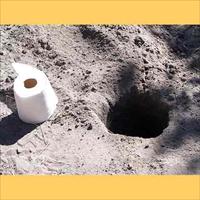LIBERIA: No relief as most Monrovians go without toilets

With just one in 25 Liberians having access to a toilet, most use the nearest bush or beach, unwittingly committing what the UN Children’s Fund (UNICEF) calls “the riskiest sanitation practice”.
Liberia’s 3.5 million people share just 19,690 toilets, according to a government water and sanitation sector assessment from October 2008, and fewer than one in three Liberians have access to safe drinking water, according to the head of Liberia’s Water and Sewer Corporation, Hun-Bu Tulay.
“Open defecation is one of the riskiest sanitation practices," Chris Cormency, UNICEF's regional water and sanitation adviser, told IRIN. "Disease-carrying materials are basically shared with neighbours and the community as a whole, allowing numerous vectors for contamination as the faeces is not isolated.”
Poor water and sanitation infrastructure contributes to high child deaths from malaria and diarrhoea, which kill 42 percent and 22 percent of Liberian children under age five, respectively, according to the NGO members of the water and sanitation or ‘WASH’ consortium in Liberia. The NGOs support the government to build up the country’s water and sanitation network and advocate for more donor funding.
Many other West African countries have similarly poor water and sanitation systems. UNICEF and the World Health Organization (WHO) predict that if current trends continue, not a single country in the region will be on target to meet the water and sanitation Millennium Development Goal of halving the proportion of people without access to safe drinking water and basic sanitation by 2015.
The non-profit World Toilet Organization, hoping to highlight the need for better toilets worldwide, has designated 19 November 'World Toilet Day'.
Urban squeeze
While rural water and sanitation facilities usually fare worse than urban ones in West Africa, partly due to government expenditure patterns and relatively higher poverty levels, the capital Monrovia’s “dire sanitation facilities” bucks this trend, according to WASH consortium advocacy manager Muyatwa Sitali.
Congested housing, no requirement that landlords provide working toilets, and virtually no urban planning have combined to create lethal sanitation conditions in the capital, Sitali said. Monrovia’s population has almost tripled since the end of the war in 2003, straining the capacity of the city’s outdated water-pipe network.
“Most of our pipes and other facilities are obsolete and need to be upgraded to improve water supply,” the Water and Sewer Corporation’s Tulay said. But many of the facilities were looted during the war.
In the Monrovia neighbourhood of West Point up to 70,000 people share 32 public washrooms which have four functioning toilets among them. “And this is one of the better managed water and sanitation areas in the capital,” Sitali said.
Cannot afford to flush
The decrepit infrastructure means toilet-users may have to use up to four gallons of water each time they flush, according to civil servant Florence Nimely, who lives in the city-centre.
“At US 25 cents a gallon, for some it is a choice between flushing and affording to buy food at the end of the day,” Nimely said. Per capita income in Liberia was US 40 cents per day in 2007, according to the World Bank.
Most Liberians are forced to buy all their water – for drinking and other uses – from street vendors at inflated prices.
“When some of my neighbours defecate they cannot get enough water to flush their toilets, so they sometimes throw the faeces around the place, exposing us all to health hazards,” Monrovia shopkeeper Samuel Tweh told IRIN.
Without regular running water, waste flushed into the system often backs up, causing sewage to spill out of manholes into the streets, according to inhabitants who rated sanitation as their top development priority in a series of assessments undertaken by the NGO Water Aid in 2008.
National and international efforts
The government has not been idle, Tulay told IRIN, adding that since President Ellen Johnson-Sirleaf came into power in Monrovians’ water supply has become more regular.
But much work remains. Currently just one water treatment station of nine across the country is working. “If we can get our facilities fully rehabilitated so all nine stations work, then most of the interior of Liberia could access safe drinking water,” Tulay said.
The government needs US$143 million to revitalise the water and sanitation network, according to the latest poverty reduction strategy issued at an April 2008 Liberia donor conference in Bonn, Germany, but as of May 2008 just $57.5 million had been committed.
“The government is doing the best it can, but its resources remain far below the amount needed,” the WASH consortium’s Sitali told IRIN. “Water and sanitation interventions should be given as much priority as meeting health, education or other development goals. This ‘development emergency’ is not being taken on board by the international community.”
The Liberian government recently launched its 2008-2011 sanitation management programme, which aims to deliver clean water to half of Monrovia’s residents by 2011, and improve access across all 15 regions.
WASH consortium members Oxfam GB, Concern, Tearfund, Action Contre La Faim, and Solidarité plan to help the government reach its goals, with funding from the UK’s Department for International Development (DFID), the European Union’s humanitarian branch, ECHO, and Irish Aid. UNICEF and the African Development Bank are also providing assistance.
 Back and Next - Back and Next
Back and Next - Back and Next See Also - See Also
See Also - See Also